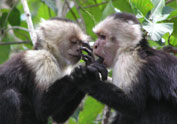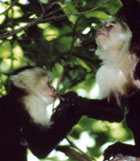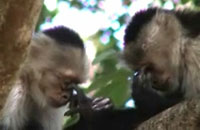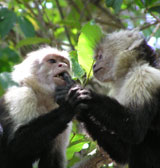|
|
|

|
|

|
|
|
CAPUCHIN TRADITIONS PROJECT |
|
|
|
|
|
|
|
 Since 1997, a group of
10 researchers has been collaborating on a study of traditions in
white-faced capuchin monkeys. We have concentrated our efforts on three
behavioral domains: social conventions, foraging techniques, and
interactions with members of other species. We have worked at 4 different
research sites in Costa Rica, which are ecologically similar and close
enough geographically that there is unlikely to be much genetic variation
between sites. The map indicates the
locations of the study groups and sites within Costa Rica. We have
collectively observed these monkeys for over 19,000 hours over a 13-year
period: this table gives some details on
the database. Since 1997, a group of
10 researchers has been collaborating on a study of traditions in
white-faced capuchin monkeys. We have concentrated our efforts on three
behavioral domains: social conventions, foraging techniques, and
interactions with members of other species. We have worked at 4 different
research sites in Costa Rica, which are ecologically similar and close
enough geographically that there is unlikely to be much genetic variation
between sites. The map indicates the
locations of the study groups and sites within Costa Rica. We have
collectively observed these monkeys for over 19,000 hours over a 13-year
period: this table gives some details on
the database.
image: Sharon Kessler |
|
|
|
|
|
|

|

|

|
|
|
|
|
|
|
Much of our work thus far has focused on social conventions: dyadic
social behaviors or communicative behaviors that are unique to particular
groups or cliques. We began this phase of the project by nominating
various quirky social interactions or communicative signals that we had
witnessed, soliciting data on these behaviors from the researchers at all
sites, and subjecting them to a set of operational criteria that allowed
us to classify a subset of the nominations as traditions.
What is a tradition?: We defined a
tradition as "a behavioral practice that is relatively long-lasting
and shared among members of a group, each new practitioner of the
behavior relying to some extent upon social influence to learn to perform
the behavior." We subjected candidate behaviors to the following
criteria to determine whether they qualified as traditions:
- There must be
intergroup variation in the behavior, such that it is common (i.e.
seen at a rate of at least once/100 hours) in one or more group and
absent in other groups that have been observed for at least 250
hours.
- The behavior must be
observed to spread through a social network.
- The behavior must
endure in the repertoire for at least a 6-month period.
Five behavior patterns were nominated as likely traditions:
hand-sniffing, sucking of body parts (though this one did not meet
criterion #2, perhaps due to the timing of our field seasons in relation
to the onset of the tradition), and 3 kinds of games. This chart shows the distribution of each
behavior pattern across the study groups. |
|
|
|
|
|
|

|

|

|
|
|
|
|
|
|
 Handsniffing: Handsniffing:
Two basic variants of this behavior are observed: one in which the
hand was cupped over the nose and mouth, and another in which the fingers
were inserted in the nostrils. At Lomas Barbudal, it was quite common for
the behavior to be mutual, with the two participants inserting their
fingers in one another’s nostrils simultaneously. The hand-sniffers
remain in this pose for several minutes at a time, sometimes swaying
gently as they sniff. Observers often describe the facial expressions as
"trance-like." In two groups (Cuajiniquil and Station Troop),
handsniffing was often combined with finger-sucking behavior. This photo
depicts the beta female (Squint) sniffing the alpha female's hand.
Click here to watch a
video. (RealPlayer - Free Download, click here). |
|
|

|
|
|
|

|

|

|
|
|
Top |
|
|
|
|
|
|
|
 Eyeball-Poking: Eyeball-Poking:
Since the publication of the original set of articles on capuchin
social traditions, we have been documenting the spread of a new tradition
in Pelon group – eyeball-poking. In this ritual, one participant
inserts its finger in the other’s eyeball, slipping the finger deep
between the eyelid and the bottom of the eyeball up to the first knuckle.
As in handsniffing, the pair remains in this posture for up to several
minutes, and often the one being poked in the eye inserts fingers in the
partner’s nostrils or mouth during the eyeball-poking.
Click here to watch a video
(RealPlayer - Free Download, click here). |
|
|
|
|
|
|

|

|

|
|
|
|
|
|
|
 Sucking
of body parts: Sucking
of body parts:
In this behavior pattern, one individual inserts some body part of the
partner (usually an ear, finger, or tail-tip) into its mouth and sucks on
it for several minutes. Sometimes the behavior is mutual, especially with
tail-sucking. As in hand-sniffing, the participants are relaxed, often
grooming before the onset of the behavior, and a bit isolated from the
rest of the group.
image: Sharon Kessler |
|
|
|
|
|
|

|

|

|
|
|
|
|
|
|
Games:
Three behavior patterns were referred to as games, because they
involved 2 roles and occurred in a relaxed social context, often stemming
from slow-motion play wrestling, play biting or grooming of the mouth. In
all of these games, one individual takes an object (finger, hair, or
inanimate object) into his mouth and bites down hard enough that it is
hard to extract. The partner tries to retrieve the object, sometimes
using the other hand, feet and mouth to pry open
the other’s mouth. When the object or body part has been retrieved,
it is reinserted into a mouth, and the game is usually played for several
more rounds. Sometimes the monkeys switch roles. Three basic variants
were observed:
Finger-in-mouth game:
This variant involves insertion of a finger into the partner’s
mouth (either partner can be responsible for insertion of the finger).
Sometimes this game starts in the context of grooming of the mouth or a
“dental exam.” The biter usually bites down firmly enough
that it is quite difficult to remove the finger, but not hard enough to
draw blood. Sometimes this game is combined with elements of the
finger-sucking behavior described elsewhere. This variant is observed
only at Lomas Barbudal. The photo sequence alongside
this page show Guapo biting the finger of a juvenile companion,
who is trying to retrieve his finger.
Hair-in-mouth game:
In this variant, one individual bites a large tuft of hair from the face
or shoulders of the partner. The partner may flinch, but does not exhibit
much pain. The partner then typically tries to pry open the mouth and
retrieve the hair. The hair is passed with gentle force from mouth to
mouth until most of it has fallen to the ground. Then one of the monkeys
bites another tuft of hair from the partner so they can continue. The
hair game is observed only at Lomas Barbudal.
Toy game:
In this variant, an inanimate object (a stick, green fruit, leaf, or
piece of bark) is passed from mouth to mouth in the same manner in which
the hair or finger is transferred in the other games. No one consumes the
toy at the end. This is the one game that is seen in multiple sites
(Lomas Barbudal and Curú). This video clip (courtesy of Mary Baker) shows
two males from Bette’s group in Curú, Bud and Angelo, playing the
toy game (though the “toy” -- a piece of bark -- is very
small and difficult to see in this clip). Angelo is soliciting the game,
and Bud is trying to remove the bark from his mouth.
Click here to watch a video.
(Please have the latest version of Adobe Flash Player installed)
|
|
|
|
|
|
|

|

|

|
|
|
Top |
|
|
|
|
|
|
|
|
|
|
|
|
|
|
|
|
|
|
|
|
|
|
|
|
|
|
|
|
|
|
|
|
|
|
|
|
|
|
|
|
|
|
|
|
|
|
|